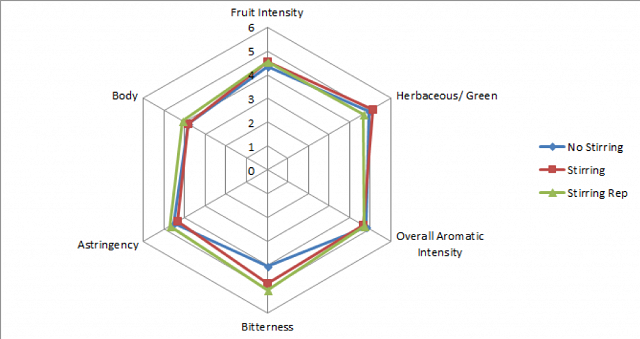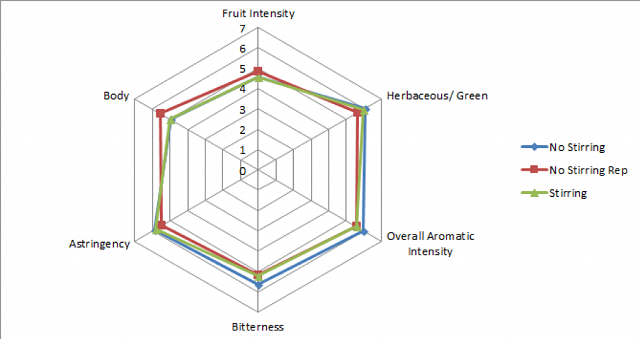The Impact of Barrel Stirring on Cabernet Franc (2017)
Kirsty Harmon
Blenheim Vineyards
Summary
This study examines the effect of barrel stirring during aging on Cabernet Franc. Cabernet Franc wine (free run and pressings) was settled for 48 hours and then racked into two identical neutral barrels. After malolactic fermentation, barrels were sulfited and one barrel was left unstirred whereas the other barrel was stirred once per week for three months. All other treatments between wines were equal. Wine chemistry was not different between treatments. The barrel stirred wine had slightly higher levels of acetic acid bacteria, some lactobacillus species, and perhaps Saccharomyces cerevisiae. O. oeni was higher in the barrel stirred treatment as well. Tannin may have been slightly lowered by barrel stirring, and catechin may have slightly increased. Overall, the wines were not found to be significantly different. Of the people who correctly distinguished the wines, there may have been a slight preference for the unstirred wine (although the tendency to have no preference was also strong). This study should be repeated again in the future, perhaps with differing levels of lees in each treatment as well and with the turbidity measured.
Introduction
Marchal et al. (2011) provide an excellent brief review of yeast autolysis in their introduction. Lees are mainly composed of yeast, bacteria, tartaric acid, polysaccharides, and protein-tannin complexes (Zoecklein 2013). Heavy lees generally refers to lees which precipitate 24 hours after fermentation (generally grape particles and large complexes of other lees particulates), and can often lead to offaromas in wine. Light lees precipitate later and are generally beneficial to wine quality, and have less grape particulates and less heavily complexed yeasts and other lees particulates (Zoecklein 2005; Zoecklein 2013). Lees aging can decrease vanilla flavors from oak, and increase toasted flavors (Chatonnet et al. 1992; Tominaga et al. 2000). Others have observed that lees stirring increases yeast character in the wine, decreases fruit and oak character. In some cases, this reduction in oak character can increase the perception of fruit (relative to very oaky control wines) (Zoecklein 2005).
Lees aging also increases the polysaccharide content of wines, particularly mannoproteins, which may enhance wine protein and tartrate stability (Llaubères et al. 1987; Ledoux et al. 1992; Moine-Ledoux et al. 1997; Feuillat 2003; Zoecklein 2005; Zoecklein 2013). Sur lies aging releases mannoproteins and other cell wall polysaccharides which can enhance the colloidal structure, stability, and aromatic quality of red wines while reducing their astringency, making sur lie aging of red wines important (Zoecklein 2005). Although yeast-derived proteins can increase during lees aging, these proteins are not involved in protein instability (Zoecklein 1991).
Lees may also act to preserve fruity and varietal characteristics by preventing oxidation and producing a reducing environment (Marchal et al. 2011; Zoecklein 2013). The release of thiols into the wine from yeast has been attributed to lowering reductive characteristics by being able to oxidize methanethiol and ethanethiol into their nonvolatile disulfide forms (Lavigne and Dubourdieu 1996); however, this greatly depends on other factors in the aging process, and could impart a more reductive character to the wine. Yeast glycoproteins from autolysis may also decrease astringency in wines through interaction with phenolic compounds (Escot et al. 2001). Lees autolysis can also impart sweetness to wine (Zoecklein 2005; Marchal et al. 2001), which may be in part due to sweet peptide fractions released during cell autolysis. One such fraction appears to be derived from heat shock proteins (Hsp12p) (Marchal et al. 2011), which is expressed from high temperature, ethanol, oxidative stress, and glycerol concentrations (Varela et al. 1995). All of these factors are present under winemaking conditions (Marchal et al. 2011). The breakdown of peptides can result in aromatic precursors in wines (Zoecklein 2005), but may also provide more nitrogen for spoilage organisms to consume. Many of these impacts of lees aging can be affected by winemaking practices, such as frequency of stirring, amount of lees present, amount of oxygen ingress, pectinase/glucosidase enzyme additions (such as Extralyse by Laffort), and perhaps even quality of lees. This study examines the impact of one such lees stirring regime on the chemical and sensory qualities of red wine.
Results and Discussion
Wine chemistry was not different between treatments. The barrel stirred wine had slightly higher levels of acetic acid bacteria, some lactobacillus species, and perhaps Saccharomyces cerevisiae. O. oeni was higher in the barrel stirred treatment as well. Tannin may have been slightly lowered by barrel stirring, and catechin may have slightly increased.
|
|||||||||||||||||||||||||||||||||||||||||||||||||||||||||||||||||||||||||||||||||||||||||||||||||||||||||||||||||||||||||||||||||||||||||||||||||||||||||||||||||||||||||||||||||||||||||||||||||||||||
|
Ethanol (%vol/vol) |
Residual Sugar (g/L) |
pH |
TA (g/L) |
Volatile Acidity (g/L) |
Malic Acid (g/L) |
Lactic Acid (g/L) |
Ammonia (mg/L) |
NOPA (mg N/L) |
YAN (mg N/L) |
Total SO2 (ppm) |
Free SO2 (ppm) |
Molecular SO2 (ppm) |
|||||||||||||||||||||||||||||||||||||||||||||||||||||||||||||||||||||||||||||||||||||||||||||||||||||||||||||||||||||||||||||||||||||||||||||||||||||||||||||||||||||||||||||||||||||||||||
|
No Stirring |
13.76 |
<1 |
3.71 |
4.04 |
0.51 |
<0.15 |
1.41 |
<10 |
32 |
36 |
84 |
40 |
0.76 |
||||||||||||||||||||||||||||||||||||||||||||||||||||||||||||||||||||||||||||||||||||||||||||||||||||||||||||||||||||||||||||||||||||||||||||||||||||||||||||||||||||||||||||||||||||||||||
|
Stirring |
13.75 |
<1 |
3.70 |
4.03 |
0.49 |
<0.15 |
1.44 |
<10 |
31 |
35 |
82 |
41 |
0.79 |
||||||||||||||||||||||||||||||||||||||||||||||||||||||||||||||||||||||||||||||||||||||||||||||||||||||||||||||||||||||||||||||||||||||||||||||||||||||||||||||||||||||||||||||||||||||||||
|
% Change |
0% |
0% |
0% |
-4% |
2% |
-3% |
-3% |
-2% |
3% |
4% |
|||||||||||||||||||||||||||||||||||||||||||||||||||||||||||||||||||||||||||||||||||||||||||||||||||||||||||||||||||||||||||||||||||||||||||||||||||||||||||||||||||||||||||||||||||||||||||||
|
Results from ICV in Mid April, Except Nitrogen from ETS
|
|||||||||||||||||||||||||||||||||||||||||||||||||||||||||||||||||||||||||||||||||||||||||||||||||||||||||||||||||||||||||||||||||||||||||||||||||||||||||||||||||||||||||||||||||||||||||||||||||||||||


